Bioreparants: principal differences from biorevitalizants and other mesotherapeutic preparations
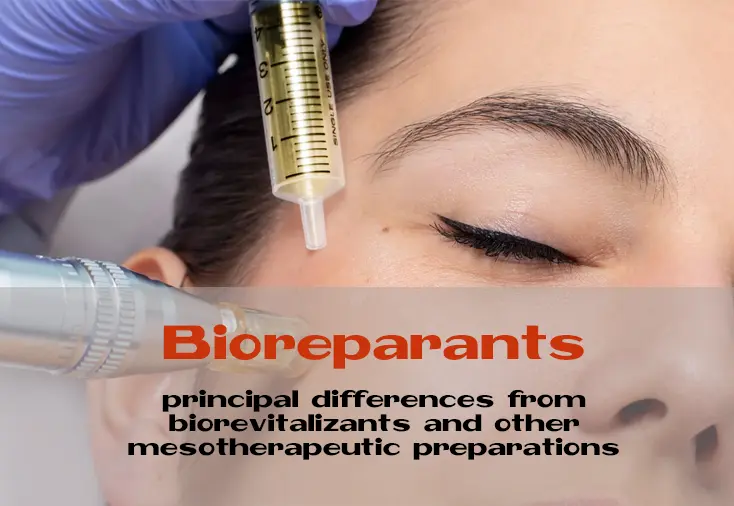
Interest in injection methods in cosmetology is steadily growing. Of course, today contour plastics and botulinum therapy are the most relevant and affordable rejuvenation procedures. They allow for a single visit to create a young “sculpture” of the face. However, these procedures have no effect on the quality of the skin and cannot remove dermal wrinkles, dryness, or improve the complexion. In addition to age-related changes, there are many aesthetic problems (dehydration, couperose, hypersensitivity), which require intervention in the skin. To this end, therapeutic techniques such as mesotherapy, biorevitalization and bioreparation are used. All methods involve intradermal and hypodermal injection of therapeutic agents. However, each of them has its own characteristics, advantages and differences.
N.P. Mikhailova
Candidate of Medical Sciences, Dermatologist, cosmetologist, associate professor of skin diseases and cosmetology department of FDPO N.I. Pirogov Russian Medical University. Pirogov, Research Director of SC “Martinex”, head doctor of “Reforma” author clinics, president of the National Society of Mesotherapy and the Eurasian Association of Injection Methods Specialists, ENTERESTET project manager, expert of SINCLAIR PHARMA, Great Britain, SuissElle, Switzerland, member of the American Academy of Dermatology (AAD) and the American Society for Laser Medicine and Surgery (ASLMS), Moscow.
MESOTHERAPY

Mesotherapy is undoubtedly one of the leading methods in the arsenal of doctors of aesthetic medicine. The prerequisites for its appearance were the invention of the syringe and the injection method of drug administration, the receipt of procaine by Alfred Einhorn in 1905 and a series of scientific discoveries in the field of physiology and neurophysiology [6]. In 1958, Dr. Michel Pistor coined the term “mesotherapy” and published an article “Summary of the new properties of procaine in its local administration for various pathological conditions in man” describing the results of his research. On April 21, 1964 Pistor organized the French Society of Mesotherapy. Michel Pistor defined the concept of mesotherapy in a short phrase: “little, rarely and in the right place”. [3]. On June 16, 1987 the French National Medical Academy officially recognized mesotherapy as an independent medical specialty. In 2006 the method was officially recognized in Russia.
Mesotherapy is a method of correction of pathological conditions by affecting the connective tissue formed from the mesodermal sheet during embryogenesis, as well as the impact on pathological processes and local immunity of neighboring organs and tissues due to the high “conductivity” of connective tissue.
With injections, active substances in a minimum dose are delivered directly to the skin cells, due to which the existing deficiency of these substances (e.g., amino acids, trace elements, hyaluronic acid) is filled, microcirculation and tissue trophism are improved. Also mesotherapy gives a positive result not only due to the specific action of the drugs, but also due to the puncture effect, so there are many different injection techniques. Damage to the integrity of tissues with a needle leads to stimulation of regeneration processes and subsequent remodeling of the extracellular matrix. Special injection techniques allow the necessary substances to be delivered to the epidermis, dermis and hypodermis. Each injection technique is not just a method of drug delivery, but also solves a number of aesthetic problems on its own. That is why several injection techniques are used within a classic mesotherapy session.
The classic technique (synonyms: “needle by needle”, “mesopuncture”) is the main technique during a mesotherapy session and ensures uniform distribution of injected substances in the dermis (Fig. 1). According to the theory of the third microcirculatory system of Multedo [1], after introduction the drugs are deposited in the interstitial space of the dermis, then they gradually spread through the intercellular space, affecting pathological processes of the adjacent organs and tissues. The classic technique is used in order to obtain a reflex, neurohumoral and maximum pharmacological effect of the method, therefore it is necessarily used at each mesotherapy session and plays the main role, and other techniques only supplement it.
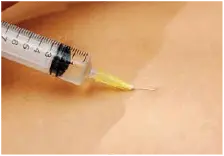
FIG. 2. The “surface nappage” technique.
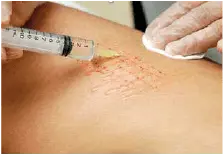
FIG. 3. Technique “median nappage”.
Nappage technique (synonyms: “coating”, “picotage”) complements the classic mesotherapy session and is used to stimulate metabolic processes, mainly due to reflexive increase of blood circulation in the skin. Depending on the technique (superficial, median or deep nappage) the drug is injected at the level of the epidermis, dermoepidermal junction or dermis. Superficial nappage is used for mesopilling and administration of vitamin complexes to instantly improve the complexion (Fig. 2). Midline nappage is highly effective for decreased skin tone, multiple epidermal wrinkles in combination with dry skin, couperose and other aesthetic imperfections (Fig. 3). Deep nappage is used to treat areas of loose skin on the body.

FIG. 4.The “papule” technique.
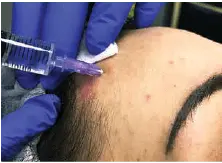
FIG. 5. The “tubercles” technique.
The main purpose of the papule and tubercle techniques is to create a drug depot in the dermis. The “papule” technique is used to inject drugs into the papillary layer of the dermis, and the “tubercles” technique – into the reticular layer (Fig. 4, 5).
The indications for using the linear technique are age-related changes (wrinkles, folds, skin laxity), and atrophic scars. The linear technique creates a depot of the drug in the dermis and traumatizes the tissues (Fig. 6).
Infiltration is a technique of drug administration that creates a depot of substances in the hypodermis. In aesthetic medicine, infiltration is used to correct cellulite, localized fat deposits on the face and body (Fig. 7).
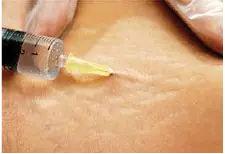
FIG. 6. Linear technique.
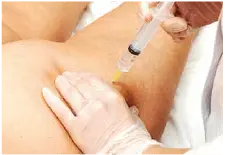
FIG. 7. Infiltration technique.
The main purpose of mesotherapy is to treat a variety of pathological conditions, consisting in locoregional parenteral administration of drugs in very low doses, carried out at certain intervals, which provides a reduction of iatrogenic effects and increases the effectiveness of therapy.
Currently, there are many mesotherapy drugs with different pharmacological effects. The doctor can choose exactly the drug that is necessary to achieve a pronounced result of the therapy. The specialist has the possibility to use monopreparations, ready-made cocktails or mix the components independently – ex tempore (Table 1).
The advantages of preparing cocktails independently include an individualized approach to the patient and the possibility to use the maximum allowable therapeutic concentrations of the ingredients. Drugs injected superficially (intradermal) take significantly longer to elimination than, for example, intramuscular injections. The rate of diffusion into the blood and lymphatic streams of the injected substance is inversely proportional to its molecular weight. Due to the low doses and high bioavailability, the drugs and their mixtures are deposited and have their effect at the injection site until they are completely consumed by the cells, destroyed by intercellular enzymes or by hydrolysis. In spite of the fact that during surface injection the active substances are carried away slower by the general blood flow from the created depot, the duration of drug retention in the tissues is short – 1-3 days.
TABLE. 1. Mesotherapeutic preparations and their application zones.
| Mesotherapy zone | Monopreparations | Cocktail examples | Ready-made cocktails |
| Face-neck-decolletage | Vitamin C 10% (ID Farma, Spain): ascorbic acid 10% | HYALUFORM mesolift 1% (Lab. THOSCANE, Russia): non-stabilized hyaluronic acid – 2,0 ml; Caviar (SKINASIL, Lab. THOSCANE): sturgeon caviar extract 5% – 2,0 ml; Silikin 0,5% (SKINASIL): organic silicon 0,5% – 1,0 ml. | DMAE Complex (SKINASIL): dimethylaminoethanol 3%, sodium hyaluronate 1%, organic silicon |
| Thighs and buttocks | Silikin 1% (SKINASIL, Lab. THOSCANE, Russia): organic silicon 1% | Lipocof (SKINASIL): caffeine sodium benzoate 20% – 2.0 ml; Lecarcel (SKINASIL): L-Carnitine 10% Silikin 1% (SKINASIL): organic silicon 1% – 2.5 ml | MPX-Lipolytic Complex (SKINASIL): sodium deoxycholate 0.3%, L-carnitine 10%, dandelion extract 2% |
| The hairy part of the head | Gibilan (SKINASIL, Lab. THOSCANE, Russia): Ginkgo biloba extract 7% | Zinc-Selenio-Silicio (ID Farma): oligoelements – 2.0 ml; Silikin 0.5% (SKINASIL): organic silicon 0.5% – 2.0 ml | Haircare (Laboratoire REVITACARE, France): amino acids, zinc, B vitamins |

Before the mesotherapy session itself, in correction of any aesthetic skin imperfections a vascular stage is always carried out to activate microcirculation, providing vasodilating and lymphatic drainage effect, strengthening and regulation of the capillary wall permeability, improving venous outflow, accelerating metabolic waste products, improving tissue oxygen supply (Fig. 8).
According to Bicheron’s theory of microcirculation [2], locoregionally administered medications improve local and general microcirculation impaired by disease or age-related changes. The vascular stage significantly improves the results of therapy. You can choose a ready-made cocktail like VLD Forte (SKINASIL, Lab. THOSCANE, Russia), which contains extracts of Asian centella, artichoke, cloverberry, fucus vesiculosa and troxerutin. The cocktail can also be prepared on its own (Table 2).
TABLE. 1. Amount of medicinal substance
| The drug, the composition | Quantity of preparation, ml |
| RUTINEL (ID Farma, Spain): rutoside 2.5%, cloverleaf extract | 2,0 |
| Silikin 0.5% (SKINASIL, Lab. THOSCANE, Russia): organic silicon 0.5% | 2,5 |
The number of sessions and their frequency depend on the indications and individual characteristics of the patient. The recommended course of procedures for correction of aesthetic skin flaws, for example, in the area “face – neck – decollete” consists of 8-10 treatments at intervals of 7 days, then 4 treatments at intervals of 14 days. Between courses to maintain the effect of recommended procedures once a month.
Today mesotherapy is used not only in aesthetic medicine (Fig. 9-14 ), but also in various fields of medicine (dentistry, aesthetic medicine, neurology, sports and rehabilitation medicine, etc.). A wide selection of products and techniques of their introduction into various mesotherapeutic zones allows for an individual approach to each patient. It is possible to correct problems not only of the face, but also of the body and the scalp. Mesotherapy is the only injection method that works to improve/restore the microcirculation system, which determines its pronounced therapeutic effect. However, the method is not without its disadvantages. These include: rapid diffusion of substances from the injection site, long courses (8-16 procedures), frequent visits to the beautician (once a week). As a consequence, biorevitalization appeared in the next round of injectable methods development.

FIG. 9. Patient before mesotherapy with Cytocare 502 (Laboratorie REVITACARE, France).

FIG. 10. Patient one week after mesotherapy session.
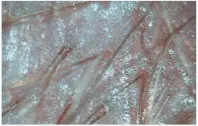
FIG. 11. Result of trichoscopy before mesotherapy with Strong Hair (SKINASIL, Lab. THOSCANE).

FIG. 12. Result of trichoscopy after completing a course of mesotherapy (12 treatments).

FIG. 13. Patient before mesotherapy with Body Lift (SKINASIL, Lab. THOSCANE).

FIG. 14. Patient after completing a course of mesotherapy (10 procedures)
BIOREVITALIZATION
Involutionary changes in the skin are the most common reason why clients consult a cosmetic surgeon. The appearance and functional properties of the skin are largely determined by the state of the intercellular matrix of the dermis. The intensity of skin aging depends on the ratio of the intensity of glycosaminoglycans metabolism and the synthesis of collagen proteins of the dermis.
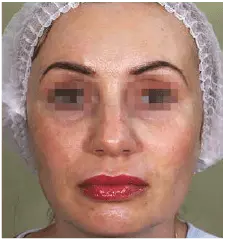
This ratio changes with age or under the influence of unfavorable environmental factors, as the rate of formation decreases and the rate of biomolecule decomposition increases. Quantitative and qualitative changes associated with hyaluronic acid lead to a decrease in skin hydration, deterioration of its ability to regenerate, immune and other protective functions of the dermis. The first mention of an unusual polysaccharide with an extremely high molecular weight, which was isolated from the vitreous body of the bovine eye, was made in the work of Karl Meyer and John Palmer, published in the Journal of Biological Chemistry in 1934. [4]. The content of hyaluronan in the human skin is not a constant value, and its deficiency can be compensated by injecting it into the dermis. This injection method in aesthetic medicine is called biorevitalization. The term “biorevitalization” was proposed in 2001 by Italian professor A. Di Pietro [5].
Biorevitalization is an injection method of intradermal injection of native or partially modified hyaluronic acid to fill its deficiency and create an optimal environment for the cellular elements of the dermis.
Initially, biorevitalizants were used based on unstabilized hyaluronic acid in concentrations of 1-2% and with a molecular weight of 1 million Da.
Intradermal introduction of native hyaluronic acid, in addition to increasing skin hydration, leads to an optimal environment for the vital activity of fibroblasts, activation of angiogenesis. Today, the choice of biorevitalizants is huge, and they differ from each other in the quality of raw materials, production technology, molecular weight and concentration of hyaluronic acid.
The main characteristic of a material based on hyaluronic acid (and preparations used in aesthetic medicine are no exception) should be the value of the molecular weight distribution (polydispersity of the polymer), that is the fractional composition of hyaluronan. Ideally, depending on the intended use, the material should consist of a fraction of hyaluronic acid with a precisely defined molecular weight [7].
The molecular weight of hyaluronan is an extremely important parameter, since macromolecules with different masses have different effects on cell behavior. So, HYALUFORM® Hydro booster (Lab. THOSCANE, Russia) includes hyaluronic acid of bacterial origin of pharmacopoeial class (high degree of purification from impurities), with a molecular mass of 2 million Dalton, which undergoes solid-phase uniform molecular-mass distribution, which allows to achieve exactly a given length of polysaccharide molecules in preparations. Uniform length of hyaluronic acid molecules ensures uniform distribution of the drug in the dermis and uniformly expressed biological effects on the entire skin area involved.
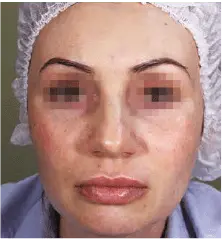
Biorevitalizants containing unmodified hyaluronic acid have a pronounced moisturizing effect and create an optimal environment for the vital activity of fibroblasts.
Relatively short biodegradation period of unstabilized hyaluronic acid is not enough to stimulate fibroblasts’ work, so the main sphere of its application is creation of a hydrospacer in the skin or its use in combination with other preparations. In order to prolong the biorevitalizing effect of hyaluronic acid were created preparations based on partially stabilized hyaluronic acid. This allows prolonging the biodegradation period of hyaluronic acid up to 14 days and ensuring the realization of all the effects of the polysaccharide within two weeks. It is very important that the production technology of these drugs ensures the safety of their use. For example, the hyaluronic acid contained in the HYALUFORM® Lift booster (Lab. THOSCANE) is partially modified by the solid-phase method using high pressure, i.e. without the use of chemical stabilizing agents. The absence of additional chemical agents ensures absolute physiology and safety of the product.
Such a preparation is more resistant to hyaluronidase action and can stay in the dermis for up to 14 days, creating during this period favorable conditions for fibroblasts to synthesize collagen and elastin fibers, which explains its powerful lifting effect (Fig. 15, 16). It is better to use preparations based on partially stabilized hyaluronic acid in cases where the skin is sufficiently moisturized, because the hydrolysis of modified hyaluronic acid requires the presence of a sufficient number of water molecules.
The recommended course of biorevitalization procedures consists of 5 procedures at intervals of 10-14 days. Reducing the number of procedures to achieve the clinical effects of biorevitalization and lengthening the intervals between them certainly represent advantages of the method. However, not all aesthetic defects (for example, couperose, hyperpigmentation, cellulite) can be corrected with biorevitalization. Preparations consisting only of hyaluronic acid stimulate fibroblast activity only indirectly. To launch a true skin rejuvenation, in addition to hyaluronic acid, the preparations need building material for cell repair, substances with specific antioxidant protection, bioregulators to accelerate biochemical reactions. Therefore, in the next round of injectable methods development it was logical to see the emergence of biorepair.
BIOREPARATION
Several years ago Russian scientists created a new class of injectable drugs – HYALREPAIR® Bioreparant, capable of solving complex aesthetic problems by starting the skin’s own reparative processes. HYALREPAIR® Bioreparant is the only injectable bioreparant of prolonged action providing a direct stimulation of the synthetic activity of fibroblasts. Allows you to achieve a pronounced and lasting rejuvenation effect. It removes all signs of aging and slows down their appearance.
Bioreparants are injectable preparations based on hyaluronic acid, stabilized by adding to it biologically active substances with geroprotective properties, namely, vitamins, amino acids, peptides and some microelements, which stimulate cell activity and normalize the skin cells. The action of bioreparants is aimed at skin rejuvenation and regeneration. Their uniqueness lies in the fact that bioreparants do not level the signs of aging, but actually rejuvenate the skin and help to preserve the potential of young cells.
Bioreparation is a method of intradermal injections of preparations of solid-phase biologically modified hyaluronic acid, aimed at correction of skin involutional changes, elimination of its damages by stimulation of processes of natural recovery and at normalization of skin cells.
For the production of bioreparants a unique technology HYALREPAIR® technology is used – the only technology (patent № 2382050), which allows a long-term retention of biologically active substances in tissues, due to which there is a direct stimulation of fibroblasts, starting skin repair and rejuvenation at the cellular level, and permanently preserved the natural youth of the skin. The technology is based on the method of modifying hyaluronic acid with biologically active substances under high pressure and shear deformation without the use of chemical crosslinking reagents.
After preliminary purification, hyaluronic acid and various biologically active substances in the form of a powdered mixture are placed on the “Bridgman’s anvil”, where under the influence of pressure and shear deformations vitamins, amino acids, peptides, trace elements are attached to hyaluronic acid, which form strong bonds with it. When injected into the tissue, these components detach from HA and have a pronounced geroprotective effect, affect cell activity, in particular stimulate the production of their own young collagen, elastin, glycosaminoglycans, including their own hyaluronic acid. Thanks to HYALREPAIR® technology the biodegradation period is extended (over 21 days) of both hyaluronic acid itself and the biologically active components attached to it.
So, for example, simple vitamin C, injected mesotherapeutically, completely disappears from the skin within 15 minutes, and in the case of bioreparants there is its gradual release from the composition with hyaluronic acid and constant maintenance of the physiological concentration for 21 days! Due to such prolonged presence of not only hyaluronic acid, but also vitamins and amino acids in the derma, there is a direct stimulation of the production of collagen, elastin, hyaluronic acid and other glycosaminoglycans by fibroblasts. This is what makes bioreparants unique and allows you to talk about true rejuvenation.
MECHANISM OF ACTION OF HYALREPAIR® PRODUCTS
- CREATION OF GEROPROTECTIVE SUBSTANCES DEPOT IN TISSUES
After the introduction of biologically active compositions of hyaluronic acid with attached amino acids, peptides, vitamins and trace elements into the dermis, a depot of biologically active substances is formed, which remains in the tissues for a long time.
- RESTORATION OF INTERCELLULAR MATRIX AND TARGETED DELIVERY OF BIOLOGICALLY ACTIVE SUBSTANCES TO CELLS
Amino acids, peptides, vitamins and microelements (vitamin C, glycine, proline, lysine, cysteine, methionine and tripeptide glutathione, Cu2+, Zn2+, Mg2+) are attached to HA molecules which form the basis of the preparation in a special way. Thanks to this modified structure of hyaluronic acid its viscosity is optimized, which ensures rapid and uniform distribution of the drug in the intercellular space.
Hyaluronic acid with optimal molecular length (2 million kDa) provides spreading of intercellular space and maintenance of three-dimensional organization of intercellular matrix components, biological stimulation of processes of natural metabolism, moisturizes, participates in transport and distribution of water in tissues, determines barrier and protective functions of intercellular space, has wound-healing effect.
- GRADUAL RELEASE OF BIOLOGICALLY ACTIVE SUBSTANCES IN PHYSIOLOGICAL CONCENTRATIONS, STIMULATION OF CELL ACTIVITY
During the whole period when biologically active substances are in tissues (about 3 weeks) their gradual release occurs, which ensures their constant presence in tissues in physiological concentrations. It is physiological concentrations of substances provide their maximum bioavailability, which creates optimal conditions for maintaining the vital activity of cells, their rapid recovery and stimulation of cell activity (rejuvenation).
- DIRECT PROLONGED STIMULATION OF CELL ACTIVITY AND REJUVENATION
Gradual detachment from hyaluronic acid of active substances, which have a stimulating effect on cells, maintains their constant presence in tissues. This provides normalization of the vital activity of cells and physiological stimulation of cell activity: production of own young collagen, elastin and glycosaminoglycans, including own hyaluronic acid. The active complex attached to HAs allows to synthesize in sufficient quantity all components of the intercellular matrix.
- LONG-TERM PRESERVATION OF THE EFFECT AND PREVENTION OF AGING
The research proves long-term preservation of the effect obtained and a 3-fold increase in the regenerative potential of skin cells. A course of bioreparation normalizes the functioning of the entire fibroblast cell pool. It provides maintenance of optimal synthesis of glycosaminoglycans (including own hyaluronic acid) and collagen and elastin fibers for a long time.
Restoration of skin protective properties and its regenerative potential allows to increase resistance of cells to the effects of endogenous and exogenous damage factors (free radicals, metabolic products, hormones, etc.) and reduce the period of cell recovery.
Each HYALREPAIR® bioreparant has its own targeted composition, representing a special combination of hyaluronic acid and the biologically active substances attached to it in a specially selected concentration and sequence. All HYALREPAIR® bioreparatives have a rejuvenating effect and can stimulate cell activity. Due to different compositions each of the preparations is best suitable for solving specific problems and improving quality of different skin types (table 3).
TAB. 3. HYALREPAIR® Bioreparant line products and indications for their use.
| The drug, the composition | Priority readings |
| HYALREPAIR® Bioreparant in syringes, 1.5 ml | |
| HYALREPAIR®-02 Bioreparant Hyaluronic acid (14 mg/ml) modified with vitamin C, proline, lysine, glycine | The fine-wrinkle type of aging Atrophic scars |
| HYALREPAIR®-04 Bioreparant Hyaluronic acid (14 mg/ml) modified with vitamin C, cysteine, glutathione | Tired type of aging Signs of photodamaged skin |
| HYALREPAIR®-08 Bioreparant Hyaluronic acid (14 mg/ml) modified with vitamin C, L-carnitine | Deformational type of aging Localized fat deposits |
| HYALREPAIR® Bioreparant in vials, 5 ml | |
| HYALREPAIR®-06 Bioreparant Hyaluronic acid (6 mg/ml) modified with vitamin C, riboflavin | Seborrhea, acne, hair loss |
| HYALREPAIR®-07 Bioreparant Hyaluronic acid (6 mg/ml) modified with vitamin C, valine, glycine, cysteine | Decreased skin tone, atrophic scars |
| HYALREPAIR®-08 Bioreparant Hyaluronic acid (6 mg/ml) modified with vitamin C, L-carnitine | Localized fat deposits on the face and body |
| HYALREPAIR®-10 Bioreparant Hyaluronic acid (6 mg/ml) modified with vitamin C, glutathione, cysteine | Signs of photodamaged skin Deterioration and loss of hair |
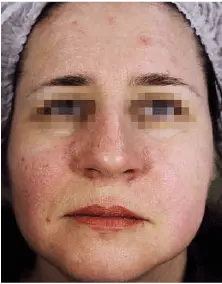
FIG. 17. Patient before the start of bioreparation with HYALREPAIR®-02 Bioreparant

FIG. 18. Patient after completion of bioreparation with HYALREPAIR®-02 Bioreparant (3 sessions)
All bioreparantines contain vitamin C bound with hyaluronic acid and have a number of general clinical effects: increase of skin tone, moisturizing, decrease of hyperpigmentation expression, strengthening of the vascular wall. Bioreparants differ from each other in form of release, viscosity, concentration of hyaluronic acid and related active ingredients. Besides they differ in additional components attached to hyaluronic acid which determine the specific action of each formulation.
HYALREPAIR®-04 Bioreparant is designed to correct aesthetic skin imperfections due to photoaging, protect the skin from damage by aggressive environmental factors, and treat hypermelanosis (Fig. 19, 20).
Application of HYALREPAIR®-08 Bioreparant allows reducing the volume of local fat deposits in combination with skin lifting in the corrected zone (Fig. 21, 22).
HYALREPAIR®-06 Bioreparant is effective for acne in adolescents and adults (Fig. 23, 24). HYALREPAIR®-08 Bioreparant in syringes is mainly injected intradermally, but to achieve the effect of fat reduction it is possible to inject it into the subcutaneous fatty tissue (HYALREPAIR®-08 Bioreparant).

FIG. 21. Patient before the start of bioreparation with HYALREPAIR®-08 Bioreparant.
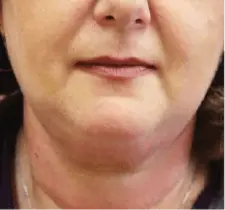
FIG. 22. Patient after completion of bioreparation with HYALREPAIR®-08 Bioreparant (3 sessions).
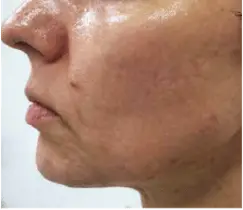
FIG. 23. Patient before the start of bioreparation with HYALREPAIR®-06 Bioreparant.
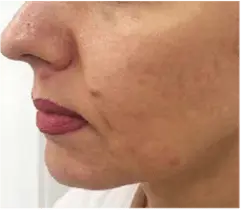
FIG. 24. after completion of a course of bioreparation with HYALREPAIR®-06 Bioreparant (5 treatments).
Bioreparant in bottles can be used with all existing mesotherapeutic injection techniques to correct aesthetic flaws of the face, body and scalp. The recommended course consists of 3 treatments at intervals of 3-4 weeks when using bioreparants in syringes, and 3-5 treatments at intervals of 2 weeks when using bioreparants in bottles.
Thus, bioreparation is a technique that was able to combine the strengths of mesotherapy and biorevitalization.
METHOD ADVANTAGES
1. Provides real rejuvenation and restoration of skin cells. 2.
2. Has a complex prolonged geroprotective effect.
3. Allows you to achieve a rapid and pronounced rejuvenation effect, noticeable after the first treatment.
4. Creates a long-term (up to 1 month) depot of hyaluronic acid with attached biologically active substances, so the interval between treatments is 3 weeks;
5. Short course (3 sessions) to achieve a pronounced rejuvenating effect.
6. Elimination of all signs of aging and prevention of their appearance.
Thus, to achieve the desired result, a specialist must not only be fluent in injection technique and take into account individual characteristics of the patient, but also have a good understanding of the mechanisms of action, priority indications and the possibilities of each method.





